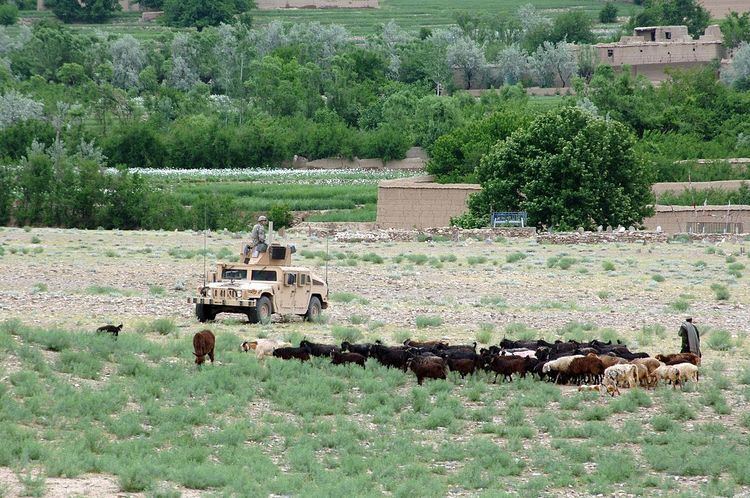 | ||
Environmental issues in Afghanistan predate the political turmoil of the past few decades. Forests and wetlands have been depleted by centuries of grazing and farming, practices which have only increased with modern population growth. In Afghanistan, environmental conservation and economic concerns are not at odds; with 80% of the population dependent on herding or farming, the welfare of the environment is critical to the economic welfare of the people. In 2007, the World Health Organization released a report ranking Afghanistan as the lowest among non-African nations in deaths from environmental hazards.
Contents
Deforestation
Much of the population depends on forests for firewood and the revenue generated by export of pistachios and almonds, which grow in natural woodlands in the central and northern regions. The Badghis and Takhar provinces have lost more than 50% of pistachio woodland. During the conflicts of the past few decades, residents and the militias such as the Northern Alliance have used wood for fuel, and these militia forces have cleared trees which could have provided hiding places for ambushes from their opponents. Further, the use of the woodlands for grazing ground and the collection of nuts for export apparently prevent new pistachio trees from growing.
Denser forests in the eastern Nangarhar, Kunar, Nuristan, and other provinces are at risk from timber harvesting by timber mafia. Although the logging is illegal, profits from exporting the timber to neighboring Pakistan are very high. The reason for this is that Pakistani government has its forests tightly protected so the timber mafia are busy cutting down trees in Afghanistan instead. The timber makes its way not only to Peshawar but also to Islamabad, Rawalpindi, and Lahore, where most of it is used to make expensive furnitures.
As forest cover decrease, the land becomes less and less productive, threatening the livelihood of the rural population and the floods are washing the agricultural lands and destroying the houses. Loss of vegetation also creates a higher risk of floods, which not only endanger the people, but cause soil erosion and decrease the amount of land available for agriculture. To tackle this problem, the Afghan government and agencies from a number of NATO states have teamed up over the past several years to turn Afghanistan green again by planting new trees.
Wildlife
With very little government infrastructure to discourage hunting, and habitat disappearing because of conflict and drought, much of the country's wildlife is at risk. In 2006, Afghanistan and the Wildlife Conservation Society began a three-year project to protect wildlife and habitats along the Wakhan Corridor and Central Plateau regions.
Little is known about the status of the salamander Batrachuperus mustersi, which is found only in the Hindu Kush.
Water management
The primary threat to Afghanistan's water supply is the droughts, which created food shortages for millions in the recent past. The resulting agricultural crises between 1995 and 2001 have driven major migrations from rural to urban areas. In response to drought, deep wells for irrigation have been drilled which decreased the under ground water level, further draining groundwater resources, which rely on rain for replenishment.
By 2003, about 99% of the Sistan wetlands were dry, another result of continued drought and lack of water management. The wetlands, an important habitat for breeding and migrant waterfowl including the dalmatian pelican and the marbled teal, have provided water for agricultural irrigation for at least 5,000 years. They are fed by the Helmand River, which ran at 98% below average in drought years 2001-2003. As in other areas of the country, the loss of natural vegetation resulted in soil erosion; here, sandstorms submerged as many as 100 villages by 2003.
Some of the major water reservoirs and dams include the following:
Pollution
Urban populations have swelled in the past several years. Since 2002, over 5 million former refugees living in Pakistan and Iran have returned home to Afghanistan. Many of these settled in the capital Kabul, which also include migrants that have come from drought-ravaged rural areas.
Nuclear waste by Pakistan
In 2008, the Afghan government alleged that Pakistan had dumped nuclear waste in southern Afghanistan during the Taliban rule (1994-2001). Farooq Wardak, Afghan Parliamentary affairs minister, said the government was setting up a commission to investigate the matter. Afghan President Hamid Karzai recently announced that his administration will investigate the matter.
Domestic and industrial waste
In 2002, the United Nations Environment Programme found that a lack of waste management systems was creating dangerous conditions in several urban areas. In Kabul's districts 5 and 6, household and medical waste was discarded on streets. Human waste was contained in open sewers, which flowed into the Kabul River and contaminated the city’s drinking water.
Urban dumpsites are used in lieu of managed landfills in Kabul, Kandahar and Herat, often without protection of nearby rivers and groundwater supplies. Medical waste from hospitals is disposed in the dumpsites with the rest of the cities’ waste, contaminating water and air with bacteria and viruses.
Lack of sewage management is not unique to Kabul. In urban areas, open sewers are common while wastewater treatment is not. Much of the urban water supply is contaminated by Escherichia coli and other bacteria.
Oil refineries are another source of water contamination. In Herat and Mazar-e-Sharif, crude oil spills and leaks are uncontained and unsafe levels of hydrocarbons reach residential water supplies.
Air pollution
Air pollution does not constitute a major problem in Afghanistan, but its reliance on inexpensive energy has created some issues. Most vehicles run on diesel fuel, and household energy often rely on burning wood and other materials. As a result, air pollution in urban areas is visible and may pose health issues.
